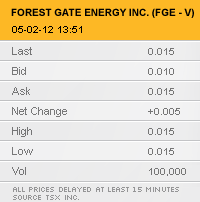Forest Gate Energy Inc.
Symbol & Exchange: FGE-V
Forest Gate Extends Remick Kimberlite Dyke To 900 Metres
Still wide open on strike and down-dip
Montreal, Quebec, March 30, 2006 - Forest Gate Resources Inc. and joint venture partner Majescor Resources report that they have completed the winter drilling and exploration program on the Portage property located directly adjacent to Ashton Mining/SOQUEM's Foxtrot property, in the northern foothills of the Otish Mountains, Quebec.
The drill program, consisting of 14 holes totaling 760 metres, was designed to delineate the northwest and southeast extension of the Remick kimberlite dyke, as well as size, shape and diamond potential.
Kimberlite, described as hypabyssal and locally macrocrystic, was intersected in 11 of the holes drilled at various angles from 9 set-ups. The width of the kimberlite intersections ranged from 4 cm to 85 cm for a total of 5.15 metres. The dyke was encountered at depths ranging from 20 to 43 metres.
"It's appears that segments of the Remick dyke are within the thickness norms for the region" said Steve Roebuck, Forest Gate's Vice President of Exploration. "Ashton Mining's press release for the Lynx dyke, dated March 20, 2006, indicates dyke thickness in Trench 184 is approximately 0.40 metres and a maximum thickness of 1.10 metres in Trench 221."
The program has extended the drill-defined strike length of the kimberlite dyke to 900 metres to the northwest from the original 2005 discovery hole, while a possible extension was intersected some 780 metres to the southeast. The correlation in the southeast area is complex as the drilling revealed that two different sets of dykes are present. While one has been encountered in two holes from one set-up, the other is known only from one drill hole, so little is known about its attitude.
A follow-up ground geophysical program is now in the planning stages to further track the kimberlite dyke and see where it might surface. "We kept the diamond drill on site so we have the option to continue drilling. We have nearly drilled the dyke to the geophysically defined limits and we still have kimberlite in the core." said Steve Roebuck. "While more drilling is an option, to do a proper assessment of the diamond potential of the Remick kimberlite dyke, we need more material and we may have to look at trenching."
In addition to drilling and ground geophysics, the winter 2006 program collected 146 lake-bottom sediment samples. The samples were collected from lakes near the head of known indicator mineral dispersion trains. Results are anticipated in six to eight weeks.
To date, only 50% of the results have been received for the glacial sediment samples collected in the fall of 2005. The material is being processed at Overburden Drilling Management's laboratory in Ottawa, Ontario. Complete results are expected by mid-May. The samples were collected in order to better define a number of dispersion trains across the property and to check anomalous, but isolated, sites from previous campaigns.

